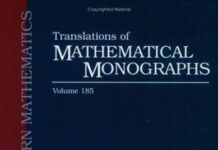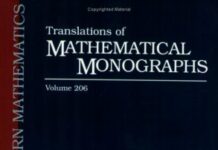
Ebook Info
- Published: 2001
- Number of pages: 184 pages
- Format: PDF
- File Size: 6.12 MB
- Authors: Kenji Ueno
Description
Modern algebraic geometry is built upon two fundamental notions: schemes and sheaves. The theory of schemes was explained in Algebraic Geometry 1: From Algebraic Varieties to Schemes, (see Volume 185 in the same series, Translations of Mathematical Monographs). In the present book, Ueno turns to the theory of sheaves and their cohomology. Loosely speaking, a sheaf is a way of keeping track of local information defined on a topological space, such as the local holomorphic functions on a complex manifold or the local sections of a vector bundle. To study schemes, it is useful to study the sheaves defined on them, especially the coherent and quasicoherent sheaves. The primary tool in understanding sheaves is cohomology. For example, in studying ampleness, it is frequently useful to translate a property of sheaves into a statement about its cohomology.
The text covers the important topics of sheaf theory, including types of sheaves and the fundamental operations on them, such as …
coherent and quasicoherent sheaves.
proper and projective morphisms.
direct and inverse images.
Cech cohomology.
For the mathematician unfamiliar with the language of schemes and sheaves, algebraic geometry can seem distant. However, Ueno makes the topic seem natural through his concise style and his insightful explanations. He explains why things are done this way and supplements his explanations with illuminating examples. As a result, he is able to make algebraic geometry very accessible to a wide audience of non-specialists.
User’s Reviews
Editorial Reviews: Review “The author includes in each chapter many examples, problems and exercises illustrating the topics discussed … The book is aimed at graduate and upper-level undergraduate students who want to learn modern algebraic geometry, but it is also very useful for other mathematicians, for example, as a very good textbook for lecture courses … Overall, this book is an excellent instructional exposition for an introduction to algebraic geometry.” —- Mathematical Reviews”This is a concept that has gained in importance in recent years, and the book under review offers an insight into why this should be so … good material … It is a clean treatment … this is a place to dig into and get facts and examples about a number of important areas in algebraic geometry … This physically compact book thus provides a good pocket guide to a subject of increasing importance.” —- Bulletin of the LMS
Reviews from Amazon users which were colected at the time this book was published on the website:
⭐This volume is an introduction to the technical heart of scheme theory, which is a theory developed by Grothendieck, and many other first rank mathematicians, to generalize, clarify and eventually provide a solution to several problems in classical algebraic geometry. This is actually the second volume of a three volume set intended to take you, in a smooth and progressive way, from the classical algebraic geometry setting, which deals with the zeros of polynomials over an algebraically closed field, to the modern setting of algebraic geometry as envisioned by Grothendieck and his school, which deals with abstract topological spaces together with a sheaf of abelian groups, rings or modules. These books were written with a strong pedagogical style, explaning many basics concepts of commutative algebra needed in these books, giving many fully developed examples and containing several exercises with solutions, or a hint for their solution, at the end of each volume. If you have had a basic graduate course in commutative algebra or read a book such as Atiyah-Macdonald’s book on commutative algebra, I would say that you are more than ready to read these books by Ueno. This three volume set can also be considered as an step towards more advanced and hard to read books like Hartshorne’s or Liu’s. There is also another book by Ueno on elementary algebraic geometry, in case you like his style.
⭐This is a good book on important ideas. But it competes with Hartshorne ALGEBRAIC GEOMETRY and that is a tough challenge. It has roughly the same prerequisites as Hartshorne and covers much the same ideas. The three volumes together are actually a bit longer than Hartshorne. I had hoped this would be a lighter, more easily surveyable book than Hartshorne’s. The subject involves a huge amount of material, an overall survey showing how the parts fit together could be very helpful, and the IWANAMI SERIES has some terrific, brief, easy to read, overviews of such subjects–which give proof techniques but refer elsewhere for the details of some longer proofs.But it turns out that Ueno differs from Hartshorne in the other direction: He gives more explicit nuts and bolts of the basic constructions. Overall it is easier to get an overview from Hartshorne. Ueno does also give a lot of “insider information” on how to look at things. It is a good book. The annotated bibliography is very interesting. But I have to say Hartshorne is better.If you get stuck on an exercise in Hartshorne this book might help. If you are working through Hartshorne on your own, you will find this alternative exposition useful as a companion. You might like the more extensive elementary treatment of representable functors, or sheaves, or Abelian categories–but you could get those from references in Hartshorne as well.Someday some textbook will supercede Hartshorne. Even Rome fell after enough centuries. But here is my prediction, for what it is worth: That successor textbook will not be more elementary than Hartshorne. It will take advantage of progress since Hartshorne wrote (almost 30 years ago now) to make the same material quicker and simpler. It will include number theory examples and will treat coherent cohomology as a special case of etale cohomology—as Hartshorne himself does briefly in his appendices. It will be written by someone who has mastered every aspect of the mathematics and exposition of Hartshorne’s book and of Milne’s ETALE COHOMOLOGY, and like both of those books it will draw heavily on Grothendieck’s brilliant, original, but thorny Elements de Geometrie Algebrique. Of course some people have that level of mastery, notably Deligne, Hartshorne, and Milne who have all written great exposition. But they can’t do everything and no one has yet boiled this down to a textbook successor to Hartshorne. If you write this successor *please* let me know as I am dying to read it.
Keywords
Free Download Algebraic Geometry 2: Sheaves and Cohomology (Translations of Mathematical Monographs) (Vol 2) in PDF format
Algebraic Geometry 2: Sheaves and Cohomology (Translations of Mathematical Monographs) (Vol 2) PDF Free Download
Download Algebraic Geometry 2: Sheaves and Cohomology (Translations of Mathematical Monographs) (Vol 2) 2001 PDF Free
Algebraic Geometry 2: Sheaves and Cohomology (Translations of Mathematical Monographs) (Vol 2) 2001 PDF Free Download
Download Algebraic Geometry 2: Sheaves and Cohomology (Translations of Mathematical Monographs) (Vol 2) PDF
Free Download Ebook Algebraic Geometry 2: Sheaves and Cohomology (Translations of Mathematical Monographs) (Vol 2)





